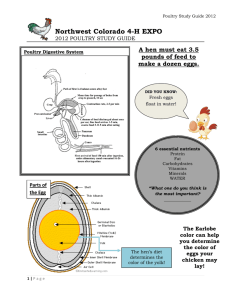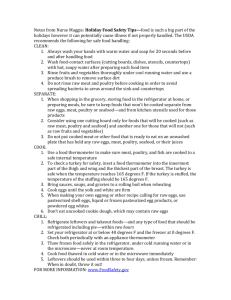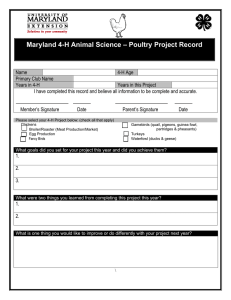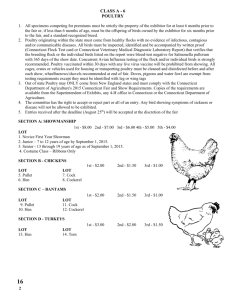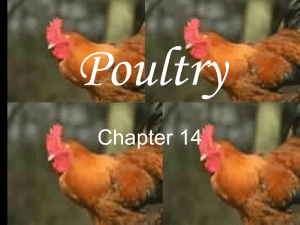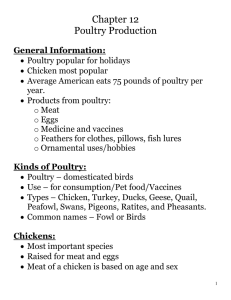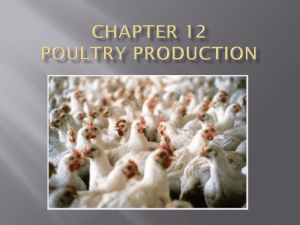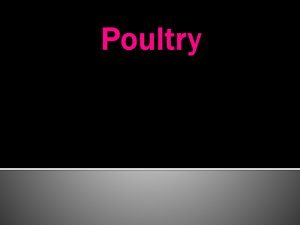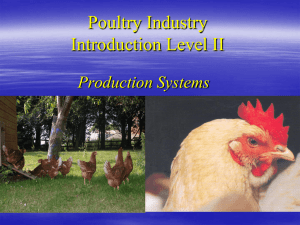NW Colorado poultry - Colorado State University Extension
advertisement
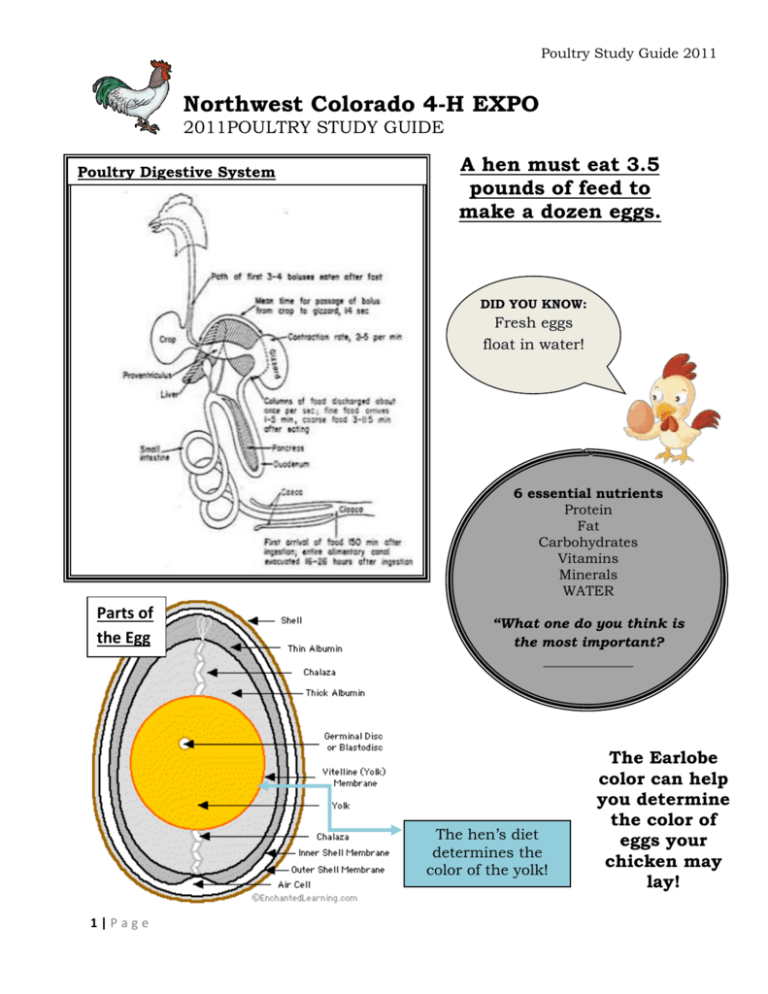
Poultry Study Guide 2011 Northwest Colorado 4-H EXPO 2011POULTRY STUDY GUIDE Poultry Digestive System A hen must eat 3.5 pounds of feed to make a dozen eggs. DID YOU KNOW: Fresh eggs float in water! 6 essential nutrients Protein Fat Carbohydrates Vitamins Minerals WATER Parts of the Egg “What one do you think is the most important? _____________ The hen’s diet determines the color of the yolk! 1|Page The Earlobe color can help you determine the color of eggs your chicken may lay! Poultry Study Guide 2011 Parts of a Chicken It is important to be able to identify the parts of your 4-H animals. Study this picture and practice identifying the parts. DID YOU KNOW: Poultry is a great source of protein! Thigh Split Breast with Back 2|Page Wing Boneless Breast Drumstick Poultry Study Guide 2011 Know the names and a few of different breedsofof cattle: Knowing the characteristic names and a few characteristic Angus: These animals are polled horns) with a black coat. They are know different breeds(no of poultry is important. for their carcass quality, milking and mothering and their Match the breeds of reproductive traits. They are the most popular breed of poultry with the cattle in the United stated. pictures. Plymouth Plymouth wasand bredcan in the Herford; These Barred animalsRock: are redThe with white faces th century in New England. They are a dual purpose 19 be polled or horned. They were brought the United breed, meaning are excellent layers Stated in 1817. Theythey became popular due to and theirmeat birds. They lay about 200 large eggs a year that is light to hardiness, feed efficiency and disposition. medium brown with a shade of pink. Simmental: Charolais A. Silkie: This is a bantam breed known for their unique Gelbvieh plumage that feels like silk. Their black meat is Limousin considered unpalatable in Europe but a delicacy in the Orient. They are docile and come in a variety of colors B. C. D. E. F. 3|Page Orpington: This heavy New England heavy breed is dual Definitions: chicken. They have a large frame with heavy Bull:purpose Male animal plumage making them appear They produce 110-160 Heifer: Female animal that has big. not yet calved light brown to tinted white eggs a year Steer: Castrated male Fattening: The process of deposition energy in the form of fat within the body tissue Rhode Island Red: This is a utility bird, raised for meat, Gestation: The length ofThey time are an animal pregnant eggs and showing. tough,isresilient and Cud:aggressive Themaking bolus ofthem eatenexcellent feed which is regurgitated andare free rangers. They further chewed. excellent egg layers, laying 250-300 eggs per year. They Expenses: items that you have purchased for your project were developed in Massachusetts and Rhode Island. Profit: when your income is larger than your expenses Loss: when your expenses are larger than your income Langshan: breedyou originated in China. It can Breakeven: TheThis priceheavy per pound need to cover your total be colored black, white or blue. The hens lay 140-150 expenses eggs a year and medication are good winter are Intravenous-applying for thelayers. benefit Their of the eggs animal directly into the blood flow brown with a plum-colored bloom. Subcutaneous: Applying medication for the benefit of the animal under the skin Intramusclar: medication for the benefit the animal Cornish applying Rock: This is the ultimate meatofbird having into genes the muscle that contribute to build a vast broiler industry. It’s muscle development and arrangement give excellent carcass shape. Their meat is fine with thick white breasts. This English breed comes in four color varieties: Dark, White, White Laced Red and Buff. Poultry Study Guide 2011 Animal Health It is very important to be able to monitor the health of your animal and be able to properly treat the animal as need. It takes a hen 23-32 hours to produce an egg! Poultry Combs 4|Page Never give medication to your animal without a parent , vet or your 4-H leader. To properly give medication to animals you must be able to understand the medication label. Be able to identify: o Name of the drug o Name of the distributor o Storage instructions o Withdrawl time o Quantity of contents o Active ingredients o Cautions and warnings Poultry Study Guide 2011 Definitions: Roughage: High fiber low energy feeds (example: hay) Concentrates: High energy low fiber feeds (example: corn) Conformation: The shape and design of an animal Pullet: A young turkey or chicken Cock: Male animal Hen: Female animal Chick: A new baby Chicken Hatching: A new chicken breaking open its egg/ being born Incubation: The length of time it takes for a chick to grow to hatch from an egg. Molt: Act of shedding or changing feathers Palatability: the degree to which a feed is liked or accepted by an animal Fattening: the process of depositing energy in the form of fat within the body tissue Dressing Percent: the amount of lean meat on a carcass. The more meat the higher the cutability Breakeven price: the price per pound you need to cover your total expenses Check: an egg with a broken or cracked shell with its contents not leaking. Immunity: the ability to resist infection. Comb: The fleshy body part of the poultry birds head Nutrients: The nourishing chemical substances such as proteins or minerals. Gizzard; The digestive part of poultry necessary for a bird to digest its food. 5|Page
